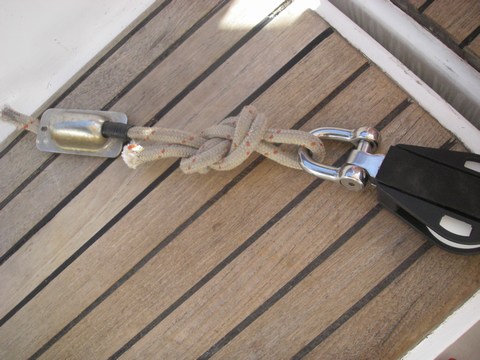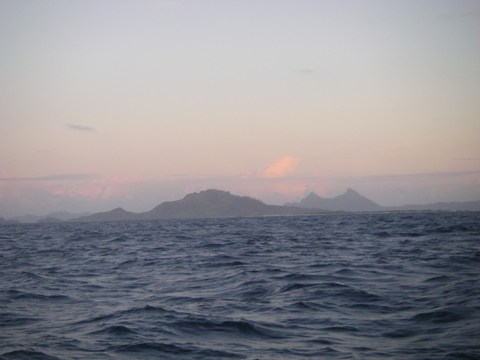To inaugurate this new « In English » category, here is the story of how Clairette, Tomtom and Schnaps crossed the Pacific Ocean.
The destination was not decided until the last week before the departure from Panama : Marquesas or Gambier ?? We did not want to stop in the Galapagos, and the distance to either of these archipelagos is almost equal : around 4000 miles from Flamenco Island on the Pacific entrance of the Panama Canal. Finally we chose the Gambier, as everyone goes to the Marquesas and we don’t always like following the crowd. Moreover, Mangareva is one of Tomtom’s dreams (from the reading at the age of 12 of Alain Gerbault’s adventures), and ‘Gambier’ is Clairette’s mother’s maiden name (and the young Clairette looked for the islands that bore that name on her Grandfather’s globe !). So let’s go to the Gambier.
Having left Panama and our friends on Maggie and Mare Liberum on the 17th of March, we quickly crossed the Equator thanks to a very strong remnant of the North-East trades that enabled Schnaps to beat a record : 175.4 miles in 24h, unbelievable in this area of usually light contrary winds. We had to go further in the South in order to catch the South-East trades, and found ourselves heading to Easter Island … why not a stop in the Island of the giant statues ? We had first decided that we would go there next time on our way to Patagonia, but we are on a sailing boat and free to change our plans as we want ! What are 200 miles more on a 4000 miles trip ? Schnaps continued therefore in the South-West in quite strong South-south-east winds and waves.
However, destiny decided for us : on the 17th day of the passage, 1000 miles away from Easter Island, we saw that one of the strands on the fore lower shroud was broken. We put the 2nd reef in the main and furled the genoa so that it looked like a storm-sail, just to see how it evolved. The next day, 4 strands were gone. In the wind, and especially the waves, the failure of the shroud was almost certain before Easter Island. Among the possible solutions, we chose to bear away and set a new course to the Gambier, 2200 miles in the West. The archipelago offers a very good shelter to wait for parts to repair the rigging, something that can hardly be found at Easter Island where there are no reefs to protect the anchorages. It’s further away but much less risky for the rigging. We tried to add some ropes, whips and tackles in order to relieve the leak part of the wire (at the usual place of failure : near the swage joint), to lengthen the shroud’s life. But we were then downwind and the tension was supposed to be decreased. No mainsail, just the n°1 jib on port and a very small furled genoa on starboard for balance …
We made some way like that for two weeks, until we heard a big CLONG coming from the mast : the aft port shroud had failed in one stroke. Quite bad! It now started to become serious. Thankfully we had put a strong sheet around the mast and the spreaders to secure the mast. After a few thoughts (and 2 ascents of the mast, quite scary when there are strange noises coming from the shrouds!), we replaced the broken shroud with an old halyard and a pulley so that we could tighten it with a winch at the mast foot. 700 miles to go … yikes!

Our new lower shroud terminal, made with an old halyard. One more trip in the mast and it will be ready for the duty !
In this part on the Pacific, we knew that we were on our own : there are maybe 3 or 4 ships a year, so we couldn’t expect any substantial help if the situation deteriorated.If, for example, we lost the mast we would have had to drift for a long time until we could reach an island with the diesel. Not a very nice possibility. We had to keep the mast up at all cost, in order to have even a small sail aloft (reefed n°1) to keep us moving.
600 miles away from the Gambier, another big noise : CLAC, this time. A quick look in the cockpit, the backstays were lose, we were sure that we were going to hear a much bigger noise, that of the mast falling down. But, nothing more happened and we went out to see that the fore-lower shroud was now completely broken and only held by the ropes we had put there the first day. We had no more « rigid » port lower shrouds. The mast was bending dangerously and we started to be really afraid. Moreover, there was a big stationary cloud in the sky that seemed to be waiting for us… When we tried to go forward to release the reef in order to accelerate and avoid this “thing”, we heard a BZZZZZ at the top of the mast, sign of an imminent lightning strike. Fortunately, it did not hit us this time, but it did convince us to burn a few litres of diesel to go away from this place as soon as possible. Awful day.
In the flat calms that followed this unpleasant episode, we removed the mainsail and the boom, in order to retain as much as possible if we were dismasted and to remove any weight we could from the rigging. We also took down the genoa for the same reason. Then we managed to add a securing rope on the starboard side (as the starboard shrouds were now subject to successive shock tensions and might also have failed from fatigue) and, last but not least, we rigged a length of chain on the port side from the spreaders base to the deck plate. This might have saved the mast, as the far lower elasticity of the chain prevented the mast from moving and bending too much, especially in the rough conditions we met in the following days. With only the stormsail, we were doing 4-5 knots in very short and high waves which were breaking on Schnaps’ transom. We had to steer manually in order to avoid big waves coming from the South, 90° off our course. Awful days.
The last week was the longest one. 400, 330, 260, 200 miles to go … Around 100 miles away from the Gambier, we saw (with the binoculars) that the aft starboard lower shroud was beginning to fail near its upper terminal. Knowing that a small northerly gale was arriving in the area, we decided that it was enough, and turned on the engine for the last 24h. In the morning of the 30th of April, after 44 days at sea, we saw the contours of the Gambier Island with an enormous relief. We knew it was not over yet, as we still had to cover 15 miles from the South-East pass to Rikitea, against 25 knots wind and without being able to use our sails, and take a narrow and tortuous channel leading to the anchorage.
At 11h30 local time we dropped the anchor – safe at last. We lay on the roof. Opened our eyes. The mast was still there.

After 44 days at sea and 4 weeks with the fear of losing the mast, it is so good to see the land ! The Gambier Islands at the sunrise of the 30th of April.
Many thanks to Colin for the corrections and ameliorations brought to this first English article !
However, destiny decided for us : on the 17th day of the passage, 1000 miles away from Easter Island, we saw that one of the strands on the fore lower shroud was broken. We put the 2nd reef in the main and furled the genoa so that it looked like a storm-sail, just to see how it evolved. The next day, 4 strands were gone. In the wind, and especially the wabes, the failure of the shroud was almost certain before Easter Island. Among the possible solutions, we chose to bear away and set a new course to the Gambier, 2200 miles in the West. The archipelago offers a very good shelter to wait for parts to repair the rigging, something that can hardly be found at Easter Island where there are no reefs to protect the anchorages. It’s further away but much less risky for the rigging. We tried to add some ropes, whips and tackles in order to relieve the leak part of the wire (at the usual place of failure : near the swage joint), to lengthen the shroud’s life. But we were then downwind and the tension was supposed to be decreased. No mainsail, just the n°1 jib on port and a very small furled genoa on starboard for balance …
We made some way like that for two weeks, until we heard a big CLONG coming from the mast : the aft port shroud had failed at once. Quite bad! It now started to become serious. Thankfully we had put a strong sheet around the mast and the spreaders to secure the mast. After a few thoughts (and 2 ascents of the mast, quite scary when there are strange noises coming from the shrouds!), we replaced the broken shroud with an old halyard and a pulley so that we could tighten it with a winch at the mast foot. 700 miles to go … yikes!
Thank you for this message !
A moi de me mettre à l’anglais !
Bisous
After reading this story, in my car, ok in the middle of the outback of Astralia, but on the ground, I can feel the soil under my feet, and even if our car broke down, that’s not the same feeling as yours.
When I read your story I was realy afraid… I didn’t know that was bad at this point.
But after all of that you should be stronger.
Well done, keep going guys !
Gnègnès, in the middle of nowhere…